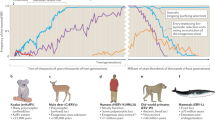Abstract
A new family of murine endogenous proviruses (VL6.0) is described here. The intact provirus is near 6 kb in length and shows a genomic organization of 5" LTR, gag, pol, env, and 3" LTR. The primer binding site (PBS) is that of a tRNAgly. The lack of functional open reading frames and occurrence of significant gaps in most, if not all, members of this group show it to be ancient. Our estimate of copy number per haploid genome is 30+. Members of this group have been isolated from Mus musculus domesticus, M. m. casteneus, M. m. hortulanus, M. caroli, and M. spretus. The occurrence of these sequences throughout such diverse members of the genus Mus may indicate that the date of the original infection predated the divergence of the extant Mus lineages at around 2.5 million years ago. Analysis of gap (deletion/insertion) patterns indicates that these sequences may have proliferated within the Mus genome by a mechanism of reverse transcriptase-mediated transposition. As yet, there are no closely related murine retroviruses described. The closest mammalian retrovirus based on sequence similarity is from the miniature swine (Sus scrofa).
Similar content being viewed by others
REFERENCES
Adams, S. E., Rathjen, P. D., Stanway, C. A., Fulton, S. M., Malim, M. H., Wilson, W., Ogden, J., King, L., Kingsman, S. M., and Kingsman, A. J. (1988). Complete nucleotide sequence of a mouse VL30 retro-element. Mol.Cell.Biol. 8:2989.
Boursot, P., Auffray, J. C., Britton-Davidian, J., and Bonhomme, F. (1993). The evolution of the house mouse. Annu.Rev.Ecol.Syst. 24:119.
Cavalier-Smith, T. (1985). The Evolution of Genome Size, Wiley, New York.
Coffin, J. M. (1993). Reverse transcriptase and evolution. In Reverse Transcriptase (S. Goff and A. M. Skalka, eds.), Cold Spring Harbor Laboratory Press, Cold Spring Harbor, NY, pp. 445–479.
Coffin, J. M. (1995). Retrovirus variation and evolution. In The DNA Provirus: Howard Temins Scientific Legacy (G. M. Copper, R. Greenberg, and B. Sugden, eds.), ASM Press, Washington, DC, pp. 221–244.
Coffin, J. M., Hughes, S. H., and Varmus, H. E. (1997). Retroviruses, Cold Spring Harbor Press, Plainview, NY.
Cordonnier, A., Casella, J. F., and Heidmann, T. (1995). Isolation of novel human endogenous retroelements with foamy virus-related pol sequence. J.Virol. 69:5890.
Henderson, T. J., and Rudikoff, S. (1993). Characterization of a Vk family in Mus musculus castaneus: sequence analysis. Immunogenetics 37:426.
Herr, W. (1984). Nucleotide sequence of AKV murine leukemia virus. J.Virol. 49:471.
Hutchison, K. W., and Eicher, E. M. (1989). An amplified endodgenous retroviral sequence on the murine Y chromosome related to murine leukemia viruses and viruslike 30S sequences. J.Virol. 63:4040.
Lueders, K. K., and Mietz, J. A. (1987). Structural analysis of type II variants within the intracistral A-particle sequence family. Nucleic Acids Res. 14:1495.
Meruelo, D., Rossomando, A., Offer, M., Buxbaum, J., and Pellicer, A. (1983). Association of endogenous viral loci with genes encoding murine histocompatibility and lymphocyte differentiation antibodies. Proc.Natl.Acad.Sci.USA 80:5032.
Mietz, J. A., Grossman, Z., Lueders, K. K., and Kuff, E. L. (1987). Nucleotide sequence of a complete mouse intracisternal A-particle genome: Relationship to known aspects of particle assembly and function. J.Virol. 61:3020.
Miller, A. D., Bonham, L., Alfano, J., Kiem, H. P., Reynolds, T., and Wolgamot, G. (1996). A novel murine retrovirus identified during testing for helper virus in human gene transfer trials. J.Virol. 70:1804.
Moore, R., Dixon, M., Smith, R., Peters, G., and Dickson, C. (1987). Complete nucleotide sequence of a milk-transmitted mouse mammary tumor virus: Two frameshift suppression events are required for translation of gag and pol. J.Virol. 61:480.
Obatu, M. M., and Khan, A. S. (1988). Structure, distribution, and expression of an ancient murine endogenous retroviruslike DNA family. J.Virol. 62:4381.
O'Neill, R. R., Buckler, C. E., Theodore, T. S., Martin, M. A., and Repaske, R. (1985). Envelope and long terminal repeat sequence of a cloned infectious NZB xenotropic murine leukemia virus. J.Virol. 53:100.
Resnick, R. M., Boyce-Jacino, M. T., Fu, Q., and Faras, A. J. (1990). Phylogenetic distribution of the novel avian endogenous provirus family, EAV-0. J.Virol. 64:4640.
Reuss, F. U., and Schaller, H. C. (1991). cDNA sequence and genomic characterization of intracisternal A-particle-related retroviral elements containing an envelope gene. J.Virol. 65:5702.
Rossomando, A., and Meruelo, D. (1986). Viral sequences are associated with many histocompatibility genes. Immunogenetics 23:233.
Schmidt, M., Wirth, T., Kroger, B., and Horak, I. (1985). Structure and genomic organization of a new family of murine retrovirus-related DNA sequences (MuRRS). Nucleic Acids Res. 13:3461.
Sonigo, P., Wain-Hobson, S., Bougueleret, L., Tiollais, P., Jacob, F., and Brulet, P. (1987). Nucleotide sequence and evolution of Etn elements. Proc.Natl.Acad.Sci.USA 84:3768.
Stavenhagen, J. B., and Robins, D. M. (1988). An ancient provirus has imposed androgen regulation on the adjacent mouse sex-limited protein gene. Cell 55:247.
Stoye, J. P., and Coffin, J. M. (1987). The four classes endogenous murine leukemia viruses: Structural relationships and potential for recombination. J.Virol. 61:2659.
Wang, Z. F., Krasikov, T., Frey, M. F., Wang, J., Matera, A. G., and Marzluff, W. F. (1996). Characterization of the mouse histone gene cluster on chromosome 13: 45 histone genes in three patches spread over 1 megabase. Genome Res. 6(8):188.
Wejmen, J. L., Taylor, B. A., Jenkins, N. A., and Copeland, N. G. (1984). Endogenous xenotropic murine leukemia virus related sequences map to chromosome regions encoding mouse lymphocyte antigens. J.Virol. 50:237.
Wilkinson, D. A., Mager, D. L., and Leong, J. A. (1994). Endogenous human retroviruses. In The Retroviridae (A. Levy, ed.), Plenum Press, New York, pp. 465–536.
Zimmerer, E. J., and Passmore, H. C. (1991). Structural and genetic properties of the Eb recombinational hotspot in the mouse. Immunogenetics 33:132.
Author information
Authors and Affiliations
Rights and permissions
About this article
Cite this article
Zimmerer, E.J., Carneal, J., Robertson, J.B. et al. Genome Organization and Phylogenetic Distribution of a Novel Family of Ancient Murine Endogenous Proviruses with Evidence for Transposition-Mediated Proliferation. Biochem Genet 38, 253–265 (2000). https://doi.org/10.1023/A:1002075821782
Issue Date:
DOI: https://doi.org/10.1023/A:1002075821782




